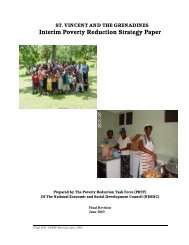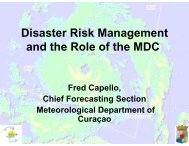The Anatomy of A Silent Crisis The Anatomy of A Silent Crisis
The Anatomy of A Silent Crisis The Anatomy of A Silent Crisis
The Anatomy of A Silent Crisis The Anatomy of A Silent Crisis
- TAGS
- anatomy
- www.bb.undp.org
You also want an ePaper? Increase the reach of your titles
YUMPU automatically turns print PDFs into web optimized ePapers that Google loves.
42 Forum 2009: Climate Change – <strong>The</strong> <strong>Anatomy</strong> <strong>of</strong> a <strong>Silent</strong> <strong>Crisis</strong><br />
security because it limits the water available for farming which can cause crops to wilt and therefore<br />
increased vulnerability <strong>of</strong> poor rural farmers. About 70 percent <strong>of</strong> the world’s run<strong>of</strong>f water withdrawals<br />
are used to irrigate farmlands — this total rises to almost 95 percent in developing countries. 122 While<br />
the daily drinking-water requirement per person is 2-4 litres, about 2,000 — 5,000 litres are needed<br />
to produce a person’s food each day. 122 This means that meeting the Millennium Development Goal<br />
target <strong>of</strong> halving hunger would require the equivalent <strong>of</strong> the world’s current water use in irrigation<br />
unless current water practices are improved. 123 This suggests that securing adequate water supply is<br />
a critical factor in stabilizing food security which is at high risk due to climate change.<br />
Less than one fifth <strong>of</strong> water is used by industry, though this value rises in developed nations<br />
signifying its importance particularly in sectors like energy that employ power plants or oil refineries. 122<br />
This leaves about 10 percent <strong>of</strong> water for domestic or municipal purposes like sanitation. 118 Access<br />
to safe drinking water and securing adequate amounts <strong>of</strong> water for hygiene are crucial to meet basic<br />
health needs. Poor people in rural and urban areas <strong>of</strong>ten have extremely limited access to safe water<br />
for household uses. For example, an average slum dweller may only have access to about 5-10<br />
litres daily, while a middle- or high-income individual living in the same city may use about 50-150<br />
litres per day. 124 An estimated 2.3 million people die every year from diarrhoeal diseases because <strong>of</strong><br />
inadequate water and sanitation. 21,125 International agencies and national policy-makers have been<br />
successful in reducing diarrhoeal deaths through efforts to improve safe water supply and health<br />
care access, but these gains may be thwarted if water scarcity increases due to climate change. At<br />
the same time increased variability and excessive water brings floods that destroy crops, overwhelm<br />
existing levees and displace millions <strong>of</strong> people every year. Climate change causes more violent<br />
swings between floods and droughts, which are hard for people to cope with absent improved<br />
storage capacity like more cisterns along with levees and dams to protect people. 118 Increased<br />
water scarcity is a principal route through which climate — change stresses will manifest themselves<br />
by impacting the availability <strong>of</strong> safe drinking water, irrigation and urban water supply — all critical<br />
components <strong>of</strong> development and poverty reduction. Thus, taking account <strong>of</strong> the changes that<br />
climate change may have on global and regional water supply is particularly pressing.<br />
Climate change exacerbates water quality and availability in regions that are already struggling<br />
hardest with water scarcity: Africa, South West Asia, the Middle East and the Mediterranean. 126<br />
In other regions, such as South Asia, climate change increases the variability <strong>of</strong> water supply, leading<br />
to floods during some parts <strong>of</strong> the year and droughts in others. 16,127 <strong>The</strong>se problems add to the<br />
vulnerability <strong>of</strong> populations in these regions whose existence is already precarious. 127,128 <strong>The</strong> map<br />
below illustrates areas that are currently impacted by water problems today due to a combination <strong>of</strong><br />
climatic and social factors 129 which reflect global change. 128,130







